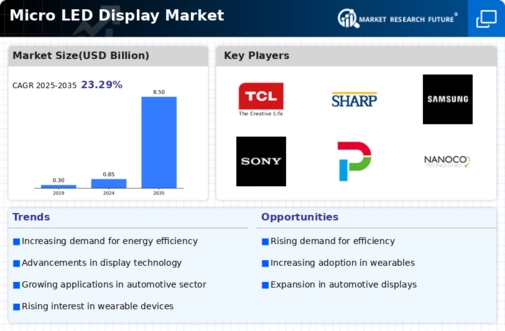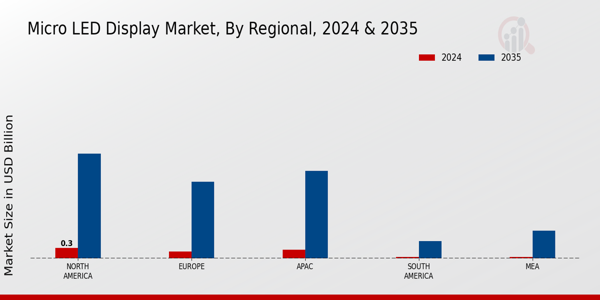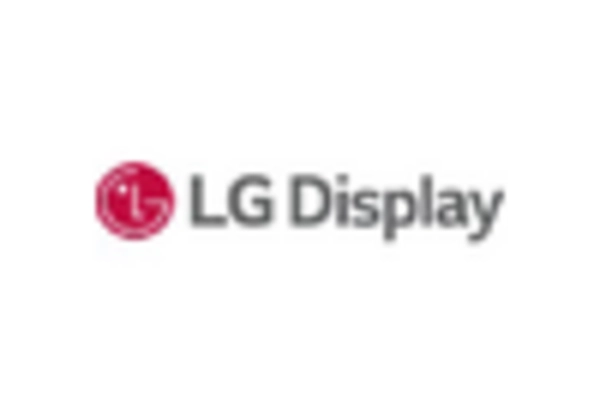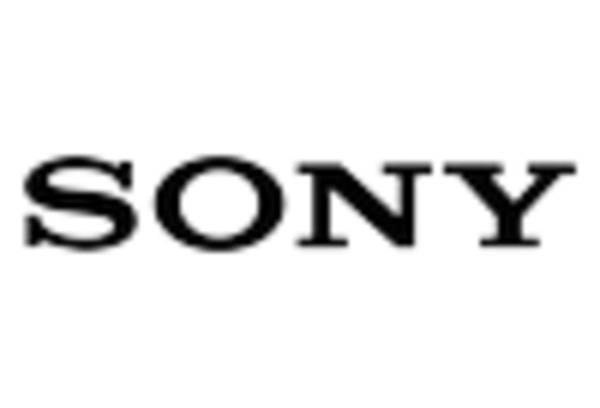-
EXECUTIVE SUMMARY
-
Market Overview
-
Key Findings
-
Market Segmentation
-
Competitive Landscape
-
Challenges and Opportunities
-
Future Outlook
-
\r\n
-
MARKET INTRODUCTION
-
Definition
-
Scope of the study
- Research Objective
- Assumption
- Limitations
-
RESEARCH METHODOLOGY
-
Overview
-
Data Mining
-
Secondary Research
-
Primary Research
- Primary Interviews and Information Gathering Process
- Breakdown of Primary Respondents
-
Forecasting Model
-
Market Size Estimation
- Bottom-Up Approach
- Top-Down Approach
-
Data Triangulation
-
Validation
-
\r\n
-
MARKET DYNAMICS
-
Overview
-
Drivers
-
Restraints
-
Opportunities
-
MARKET FACTOR ANALYSIS
-
Value chain Analysis
-
Porter's Five Forces Analysis
- Bargaining Power of Suppliers
- Bargaining Power of Buyers
- Threat of New Entrants
- Threat of Substitutes
- Intensity of Rivalry
-
COVID-19 Impact Analysis
- Market Impact Analysis
- Regional Impact
- Opportunity and Threat Analysis
-
\r\n
-
MICRO LED DISPLAY MARKET, BY APPLICATION (USD BILLION)
-
Consumer Electronics
-
Advertising
-
Automotive Displays
-
Aerospace and Defense
-
Medical Diagnostics
-
MICRO LED DISPLAY MARKET, BY PRODUCT TYPE (USD BILLION)
-
Micro LED TVs
-
Wearable Displays
-
Smartphone Displays
-
Tablets and Laptops
-
Digital Signage
-
MICRO LED DISPLAY MARKET, BY TECHNOLOGY (USD BILLION)
-
Active Matrix Micro LED
-
Passive Matrix Micro LED
-
Reflective Micro LED
-
Transparent Micro-LED
-
MICRO LED DISPLAY MARKET, BY END USE (USD BILLION)
-
Residential
-
Commercial
-
Industrial
-
Healthcare
-
Transportation
-
MICRO LED DISPLAY MARKET, BY REGIONAL (USD BILLION)
-
North America
- US
- Canada
-
Europe
- Germany
- UK
- France
- Russia
- Italy
- Spain
- Rest of Europe
-
APAC
- China
- India
- Japan
- South Korea
- Malaysia
- Thailand
- Indonesia
- Rest of APAC
-
South America
- Brazil
- Mexico
- Argentina
- Rest of South America
-
MEA
- GCC Countries
- South Africa
- Rest of MEA
-
\r\n
-
COMPETITIVE LANDSCAPE
-
Overview
-
Competitive Analysis
-
Market share Analysis
-
Major Growth Strategy in the Micro LED Display Market
-
Competitive Benchmarking
-
Leading Players in Terms of Number of Developments in the Micro LED Display Market
-
Key developments and growth strategies
- New Product Launch/Service Deployment
- Merger & Acquisitions
- Joint Ventures
-
Major Players Financial Matrix
- Sales and Operating Income
- Major Players R&D Expenditure. 2023
-
COMPANY PROFILES
-
TCL
- Financial Overview
- Products Offered
- Key Developments
- SWOT Analysis
- Key Strategies
-
Sharp
- Financial Overview
- Products Offered
- Key Developments
- SWOT Analysis
- Key Strategies
-
Samsung
- Financial Overview
- Products Offered
- Key Developments
- SWOT Analysis
- Key Strategies
-
Sony
- Financial Overview
- Products Offered
- Key Developments
- SWOT Analysis
- Key Strategies
-
PlayNitride
- Financial Overview
- Products Offered
- Key Developments
- SWOT Analysis
- Key Strategies
-
Nanoco Technologies
- Financial Overview
- Products Offered
- Key Developments
- SWOT Analysis
- Key Strategies
-
Micron Technology
- Financial Overview
- Products Offered
- Key Developments
- SWOT Analysis
- Key Strategies
-
Intel
- Financial Overview
- Products Offered
- Key Developments
- SWOT Analysis
- Key Strategies
-
Google
- Financial Overview
- Products Offered
- Key Developments
- SWOT Analysis
- Key Strategies
-
AU Optronics
- Financial Overview
- Products Offered
- Key Developments
- SWOT Analysis
- Key Strategies
-
Xiaomi
- Financial Overview
- Products Offered
- Key Developments
- SWOT Analysis
- Key Strategies
-
Apple
- Financial Overview
- Products Offered
- Key Developments
- SWOT Analysis
- Key Strategies
-
LG Electronics
- Financial Overview
- Products Offered
- Key Developments
- SWOT Analysis
- Key Strategies
-
Epistar
- Financial Overview
- Products Offered
- Key Developments
- SWOT Analysis
- Key Strategies
-
JBD
- Financial Overview
- Products Offered
- Key Developments
- SWOT Analysis
- Key Strategies
-
APPENDIX
-
References
-
Related Reports
-
LIST OF TABLES
-
\r\n
-
LIST OF ASSUMPTIONS
-
NORTH AMERICA MICRO LED DISPLAY MARKET SIZE ESTIMATES & FORECAST, BY APPLICATION, 2019-2035 (USD BILLIONS)
-
NORTH AMERICA MICRO LED DISPLAY MARKET SIZE ESTIMATES & FORECAST, BY PRODUCT TYPE, 2019-2035 (USD BILLIONS)
-
NORTH AMERICA MICRO LED DISPLAY MARKET SIZE ESTIMATES & FORECAST, BY TECHNOLOGY, 2019-2035 (USD BILLIONS)
-
NORTH AMERICA MICRO LED DISPLAY MARKET SIZE ESTIMATES & FORECAST, BY END USE, 2019-2035 (USD BILLIONS)
-
NORTH AMERICA MICRO LED DISPLAY MARKET SIZE ESTIMATES & FORECAST, BY REGIONAL, 2019-2035 (USD BILLIONS)
-
US MICRO LED DISPLAY MARKET SIZE ESTIMATES & FORECAST, BY APPLICATION, 2019-2035 (USD BILLIONS)
-
US MICRO LED DISPLAY MARKET SIZE ESTIMATES & FORECAST, BY PRODUCT TYPE, 2019-2035 (USD BILLIONS)
-
US MICRO LED DISPLAY MARKET SIZE ESTIMATES & FORECAST, BY TECHNOLOGY, 2019-2035 (USD BILLIONS)
-
US MICRO LED DISPLAY MARKET SIZE ESTIMATES & FORECAST, BY END USE, 2019-2035 (USD BILLIONS)
-
US MICRO LED DISPLAY MARKET SIZE ESTIMATES & FORECAST, BY REGIONAL, 2019-2035 (USD BILLIONS)
-
CANADA MICRO LED DISPLAY MARKET SIZE ESTIMATES & FORECAST, BY APPLICATION, 2019-2035 (USD BILLIONS)
-
CANADA MICRO LED DISPLAY MARKET SIZE ESTIMATES & FORECAST, BY PRODUCT TYPE, 2019-2035 (USD BILLIONS)
-
CANADA MICRO LED DISPLAY MARKET SIZE ESTIMATES & FORECAST, BY TECHNOLOGY, 2019-2035 (USD BILLIONS)
-
CANADA MICRO LED DISPLAY MARKET SIZE ESTIMATES & FORECAST, BY END USE, 2019-2035 (USD BILLIONS)
-
CANADA MICRO LED DISPLAY MARKET SIZE ESTIMATES & FORECAST, BY REGIONAL, 2019-2035 (USD BILLIONS)
-
EUROPE MICRO LED DISPLAY MARKET SIZE ESTIMATES & FORECAST, BY APPLICATION, 2019-2035 (USD BILLIONS)
-
EUROPE MICRO LED DISPLAY MARKET SIZE ESTIMATES & FORECAST, BY PRODUCT TYPE, 2019-2035 (USD BILLIONS)
-
EUROPE MICRO LED DISPLAY MARKET SIZE ESTIMATES & FORECAST, BY TECHNOLOGY, 2019-2035 (USD BILLIONS)
-
EUROPE MICRO LED DISPLAY MARKET SIZE ESTIMATES & FORECAST, BY END USE, 2019-2035 (USD BILLIONS)
-
EUROPE MICRO LED DISPLAY MARKET SIZE ESTIMATES & FORECAST, BY REGIONAL, 2019-2035 (USD BILLIONS)
-
GERMANY MICRO LED DISPLAY MARKET SIZE ESTIMATES & FORECAST, BY APPLICATION, 2019-2035 (USD BILLIONS)
-
GERMANY MICRO LED DISPLAY MARKET SIZE ESTIMATES & FORECAST, BY PRODUCT TYPE, 2019-2035 (USD BILLIONS)
-
GERMANY MICRO LED DISPLAY MARKET SIZE ESTIMATES & FORECAST, BY TECHNOLOGY, 2019-2035 (USD BILLIONS)
-
GERMANY MICRO LED DISPLAY MARKET SIZE ESTIMATES & FORECAST, BY END USE, 2019-2035 (USD BILLIONS)
-
GERMANY MICRO LED DISPLAY MARKET SIZE ESTIMATES & FORECAST, BY REGIONAL, 2019-2035 (USD BILLIONS)
-
UK MICRO LED DISPLAY MARKET SIZE ESTIMATES & FORECAST, BY APPLICATION, 2019-2035 (USD BILLIONS)
-
UK MICRO LED DISPLAY MARKET SIZE ESTIMATES & FORECAST, BY PRODUCT TYPE, 2019-2035 (USD BILLIONS)
-
UK MICRO LED DISPLAY MARKET SIZE ESTIMATES & FORECAST, BY TECHNOLOGY, 2019-2035 (USD BILLIONS)
-
UK MICRO LED DISPLAY MARKET SIZE ESTIMATES & FORECAST, BY END USE, 2019-2035 (USD BILLIONS)
-
UK MICRO LED DISPLAY MARKET SIZE ESTIMATES & FORECAST, BY REGIONAL, 2019-2035 (USD BILLIONS)
-
FRANCE MICRO LED DISPLAY MARKET SIZE ESTIMATES & FORECAST, BY APPLICATION, 2019-2035 (USD BILLIONS)
-
FRANCE MICRO LED DISPLAY MARKET SIZE ESTIMATES & FORECAST, BY PRODUCT TYPE, 2019-2035 (USD BILLIONS)
-
FRANCE MICRO LED DISPLAY MARKET SIZE ESTIMATES & FORECAST, BY TECHNOLOGY, 2019-2035 (USD BILLIONS)
-
FRANCE MICRO LED DISPLAY MARKET SIZE ESTIMATES & FORECAST, BY END USE, 2019-2035 (USD BILLIONS)
-
FRANCE MICRO LED DISPLAY MARKET SIZE ESTIMATES & FORECAST, BY REGIONAL, 2019-2035 (USD BILLIONS)
-
RUSSIA MICRO LED DISPLAY MARKET SIZE ESTIMATES & FORECAST, BY APPLICATION, 2019-2035 (USD BILLIONS)
-
RUSSIA MICRO LED DISPLAY MARKET SIZE ESTIMATES & FORECAST, BY PRODUCT TYPE, 2019-2035 (USD BILLIONS)
-
RUSSIA MICRO LED DISPLAY MARKET SIZE ESTIMATES & FORECAST, BY TECHNOLOGY, 2019-2035 (USD BILLIONS)
-
RUSSIA MICRO LED DISPLAY MARKET SIZE ESTIMATES & FORECAST, BY END USE, 2019-2035 (USD BILLIONS)
-
RUSSIA MICRO LED DISPLAY MARKET SIZE ESTIMATES & FORECAST, BY REGIONAL, 2019-2035 (USD BILLIONS)
-
ITALY MICRO LED DISPLAY MARKET SIZE ESTIMATES & FORECAST, BY APPLICATION, 2019-2035 (USD BILLIONS)
-
ITALY MICRO LED DISPLAY MARKET SIZE ESTIMATES & FORECAST, BY PRODUCT TYPE, 2019-2035 (USD BILLIONS)
-
ITALY MICRO LED DISPLAY MARKET SIZE ESTIMATES & FORECAST, BY TECHNOLOGY, 2019-2035 (USD BILLIONS)
-
ITALY MICRO LED DISPLAY MARKET SIZE ESTIMATES & FORECAST, BY END USE, 2019-2035 (USD BILLIONS)
-
ITALY MICRO LED DISPLAY MARKET SIZE ESTIMATES & FORECAST, BY REGIONAL, 2019-2035 (USD BILLIONS)
-
SPAIN MICRO LED DISPLAY MARKET SIZE ESTIMATES & FORECAST, BY APPLICATION, 2019-2035 (USD BILLIONS)
-
SPAIN MICRO LED DISPLAY MARKET SIZE ESTIMATES & FORECAST, BY PRODUCT TYPE, 2019-2035 (USD BILLIONS)
-
SPAIN MICRO LED DISPLAY MARKET SIZE ESTIMATES & FORECAST, BY TECHNOLOGY, 2019-2035 (USD BILLIONS)
-
SPAIN MICRO LED DISPLAY MARKET SIZE ESTIMATES & FORECAST, BY END USE, 2019-2035 (USD BILLIONS)
-
SPAIN MICRO LED DISPLAY MARKET SIZE ESTIMATES & FORECAST, BY REGIONAL, 2019-2035 (USD BILLIONS)
-
REST OF EUROPE MICRO LED DISPLAY MARKET SIZE ESTIMATES & FORECAST, BY APPLICATION, 2019-2035 (USD BILLIONS)
-
REST OF EUROPE MICRO LED DISPLAY MARKET SIZE ESTIMATES & FORECAST, BY PRODUCT TYPE, 2019-2035 (USD BILLIONS)
-
REST OF EUROPE MICRO LED DISPLAY MARKET SIZE ESTIMATES & FORECAST, BY TECHNOLOGY, 2019-2035 (USD BILLIONS)
-
REST OF EUROPE MICRO LED DISPLAY MARKET SIZE ESTIMATES & FORECAST, BY END USE, 2019-2035 (USD BILLIONS)
-
REST OF EUROPE MICRO LED DISPLAY MARKET SIZE ESTIMATES & FORECAST, BY REGIONAL, 2019-2035 (USD BILLIONS)
-
APAC MICRO LED DISPLAY MARKET SIZE ESTIMATES & FORECAST, BY APPLICATION, 2019-2035 (USD BILLIONS)
-
APAC MICRO LED DISPLAY MARKET SIZE ESTIMATES & FORECAST, BY PRODUCT TYPE, 2019-2035 (USD BILLIONS)
-
APAC MICRO LED DISPLAY MARKET SIZE ESTIMATES & FORECAST, BY TECHNOLOGY, 2019-2035 (USD BILLIONS)
-
APAC MICRO LED DISPLAY MARKET SIZE ESTIMATES & FORECAST, BY END USE, 2019-2035 (USD BILLIONS)
-
APAC MICRO LED DISPLAY MARKET SIZE ESTIMATES & FORECAST, BY REGIONAL, 2019-2035 (USD BILLIONS)
-
CHINA MICRO LED DISPLAY MARKET SIZE ESTIMATES & FORECAST, BY APPLICATION, 2019-2035 (USD BILLIONS)
-
CHINA MICRO LED DISPLAY MARKET SIZE ESTIMATES & FORECAST, BY PRODUCT TYPE, 2019-2035 (USD BILLIONS)
-
CHINA MICRO LED DISPLAY MARKET SIZE ESTIMATES & FORECAST, BY TECHNOLOGY, 2019-2035 (USD BILLIONS)
-
CHINA MICRO LED DISPLAY MARKET SIZE ESTIMATES & FORECAST, BY END USE, 2019-2035 (USD BILLIONS)
-
CHINA MICRO LED DISPLAY MARKET SIZE ESTIMATES & FORECAST, BY REGIONAL, 2019-2035 (USD BILLIONS)
-
INDIA MICRO LED DISPLAY MARKET SIZE ESTIMATES & FORECAST, BY APPLICATION, 2019-2035 (USD BILLIONS)
-
INDIA MICRO LED DISPLAY MARKET SIZE ESTIMATES & FORECAST, BY PRODUCT TYPE, 2019-2035 (USD BILLIONS)
-
INDIA MICRO LED DISPLAY MARKET SIZE ESTIMATES & FORECAST, BY TECHNOLOGY, 2019-2035 (USD BILLIONS)
-
INDIA MICRO LED DISPLAY MARKET SIZE ESTIMATES & FORECAST, BY END USE, 2019-2035 (USD BILLIONS)
-
INDIA MICRO LED DISPLAY MARKET SIZE ESTIMATES & FORECAST, BY REGIONAL, 2019-2035 (USD BILLIONS)
-
JAPAN MICRO LED DISPLAY MARKET SIZE ESTIMATES & FORECAST, BY APPLICATION, 2019-2035 (USD BILLIONS)
-
JAPAN MICRO LED DISPLAY MARKET SIZE ESTIMATES & FORECAST, BY PRODUCT TYPE, 2019-2035 (USD BILLIONS)
-
JAPAN MICRO LED DISPLAY MARKET SIZE ESTIMATES & FORECAST, BY TECHNOLOGY, 2019-2035 (USD BILLIONS)
-
JAPAN MICRO LED DISPLAY MARKET SIZE ESTIMATES & FORECAST, BY END USE, 2019-2035 (USD BILLIONS)
-
JAPAN MICRO LED DISPLAY MARKET SIZE ESTIMATES & FORECAST, BY REGIONAL, 2019-2035 (USD BILLIONS)
-
SOUTH KOREA MICRO LED DISPLAY MARKET SIZE ESTIMATES & FORECAST, BY APPLICATION, 2019-2035 (USD BILLIONS)
-
SOUTH KOREA MICRO LED DISPLAY MARKET SIZE ESTIMATES & FORECAST, BY PRODUCT TYPE, 2019-2035 (USD BILLIONS)
-
SOUTH KOREA MICRO LED DISPLAY MARKET SIZE ESTIMATES & FORECAST, BY TECHNOLOGY, 2019-2035 (USD BILLIONS)
-
SOUTH KOREA MICRO LED DISPLAY MARKET SIZE ESTIMATES & FORECAST, BY END USE, 2019-2035 (USD BILLIONS)
-
SOUTH KOREA MICRO LED DISPLAY MARKET SIZE ESTIMATES & FORECAST, BY REGIONAL, 2019-2035 (USD BILLIONS)
-
MALAYSIA MICRO LED DISPLAY MARKET SIZE ESTIMATES & FORECAST, BY APPLICATION, 2019-2035 (USD BILLIONS)
-
MALAYSIA MICRO LED DISPLAY MARKET SIZE ESTIMATES & FORECAST, BY PRODUCT TYPE, 2019-2035 (USD BILLIONS)
-
MALAYSIA MICRO LED DISPLAY MARKET SIZE ESTIMATES & FORECAST, BY TECHNOLOGY, 2019-2035 (USD BILLIONS)
-
MALAYSIA MICRO LED DISPLAY MARKET SIZE ESTIMATES & FORECAST, BY END USE, 2019-2035 (USD BILLIONS)
-
MALAYSIA MICRO LED DISPLAY MARKET SIZE ESTIMATES & FORECAST, BY REGIONAL, 2019-2035 (USD BILLIONS)
-
THAILAND MICRO LED DISPLAY MARKET SIZE ESTIMATES & FORECAST, BY APPLICATION, 2019-2035 (USD BILLIONS)
-
THAILAND MICRO LED DISPLAY MARKET SIZE ESTIMATES & FORECAST, BY PRODUCT TYPE, 2019-2035 (USD BILLIONS)
-
THAILAND MICRO LED DISPLAY MARKET SIZE ESTIMATES & FORECAST, BY TECHNOLOGY, 2019-2035 (USD BILLIONS)
-
THAILAND MICRO LED DISPLAY MARKET SIZE ESTIMATES & FORECAST, BY END USE, 2019-2035 (USD BILLIONS)
-
THAILAND MICRO LED DISPLAY MARKET SIZE ESTIMATES & FORECAST, BY REGIONAL, 2019-2035 (USD BILLIONS)
-
INDONESIA MICRO LED DISPLAY MARKET SIZE ESTIMATES & FORECAST, BY APPLICATION, 2019-2035 (USD BILLIONS)
-
INDONESIA MICRO LED DISPLAY MARKET SIZE ESTIMATES & FORECAST, BY PRODUCT TYPE, 2019-2035 (USD BILLIONS)
-
INDONESIA MICRO LED DISPLAY MARKET SIZE ESTIMATES & FORECAST, BY TECHNOLOGY, 2019-2035 (USD BILLIONS)
-
INDONESIA MICRO LED DISPLAY MARKET SIZE ESTIMATES & FORECAST, BY END USE, 2019-2035 (USD BILLIONS)
-
INDONESIA MICRO LED DISPLAY MARKET SIZE ESTIMATES & FORECAST, BY REGIONAL, 2019-2035 (USD BILLIONS)
-
REST OF APAC MICRO LED DISPLAY MARKET SIZE ESTIMATES & FORECAST, BY APPLICATION, 2019-2035 (USD BILLIONS)
-
REST OF APAC MICRO LED DISPLAY MARKET SIZE ESTIMATES & FORECAST, BY PRODUCT TYPE, 2019-2035 (USD BILLIONS)
-
REST OF APAC MICRO LED DISPLAY MARKET SIZE ESTIMATES & FORECAST, BY TECHNOLOGY, 2019-2035 (USD BILLIONS)
-
REST OF APAC MICRO LED DISPLAY MARKET SIZE ESTIMATES & FORECAST, BY END USE, 2019-2035 (USD BILLIONS)
-
REST OF APAC MICRO LED DISPLAY MARKET SIZE ESTIMATES & FORECAST, BY REGIONAL, 2019-2035 (USD BILLIONS)
-
SOUTH AMERICA MICRO LED DISPLAY MARKET SIZE ESTIMATES & FORECAST, BY APPLICATION, 2019-2035 (USD BILLIONS)
-
SOUTH AMERICA MICRO LED DISPLAY MARKET SIZE ESTIMATES & FORECAST, BY PRODUCT TYPE, 2019-2035 (USD BILLIONS)
-
SOUTH AMERICA MICRO LED DISPLAY MARKET SIZE ESTIMATES & FORECAST, BY TECHNOLOGY, 2019-2035 (USD BILLIONS)
-
SOUTH AMERICA MICRO LED DISPLAY MARKET SIZE ESTIMATES & FORECAST, BY END USE, 2019-2035 (USD BILLIONS)
-
SOUTH AMERICA MICRO LED DISPLAY MARKET SIZE ESTIMATES & FORECAST, BY REGIONAL, 2019-2035 (USD BILLIONS)
-
BRAZIL MICRO LED DISPLAY MARKET SIZE ESTIMATES & FORECAST, BY APPLICATION, 2019-2035 (USD BILLIONS)
-
BRAZIL MICRO LED DISPLAY MARKET SIZE ESTIMATES & FORECAST, BY PRODUCT TYPE, 2019-2035 (USD BILLIONS)
-
BRAZIL MICRO LED DISPLAY MARKET SIZE ESTIMATES & FORECAST, BY TECHNOLOGY, 2019-2035 (USD BILLIONS)
-
BRAZIL MICRO LED DISPLAY MARKET SIZE ESTIMATES & FORECAST, BY END USE, 2019-2035 (USD BILLIONS)
-
BRAZIL MICRO LED DISPLAY MARKET SIZE ESTIMATES & FORECAST, BY REGIONAL, 2019-2035 (USD BILLIONS)
-
MEXICO MICRO LED DISPLAY MARKET SIZE ESTIMATES & FORECAST, BY APPLICATION, 2019-2035 (USD BILLIONS)
-
MEXICO MICRO LED DISPLAY MARKET SIZE ESTIMATES & FORECAST, BY PRODUCT TYPE, 2019-2035 (USD BILLIONS)
-
MEXICO MICRO LED DISPLAY MARKET SIZE ESTIMATES & FORECAST, BY TECHNOLOGY, 2019-2035 (USD BILLIONS)
-
MEXICO MICRO LED DISPLAY MARKET SIZE ESTIMATES & FORECAST, BY END USE, 2019-2035 (USD BILLIONS)
-
MEXICO MICRO LED DISPLAY MARKET SIZE ESTIMATES & FORECAST, BY REGIONAL, 2019-2035 (USD BILLIONS)
-
ARGENTINA MICRO LED DISPLAY MARKET SIZE ESTIMATES & FORECAST, BY APPLICATION, 2019-2035 (USD BILLIONS)
-
ARGENTINA MICRO LED DISPLAY MARKET SIZE ESTIMATES & FORECAST, BY PRODUCT TYPE, 2019-2035 (USD BILLIONS)
-
ARGENTINA MICRO LED DISPLAY MARKET SIZE ESTIMATES & FORECAST, BY TECHNOLOGY, 2019-2035 (USD BILLIONS)
-
ARGENTINA MICRO LED DISPLAY MARKET SIZE ESTIMATES & FORECAST, BY END USE, 2019-2035 (USD BILLIONS)
-
ARGENTINA MICRO LED DISPLAY MARKET SIZE ESTIMATES & FORECAST, BY REGIONAL, 2019-2035 (USD BILLIONS)
-
REST OF SOUTH AMERICA MICRO LED DISPLAY MARKET SIZE ESTIMATES & FORECAST, BY APPLICATION, 2019-2035 (USD BILLIONS)
-
REST OF SOUTH AMERICA MICRO LED DISPLAY MARKET SIZE ESTIMATES & FORECAST, BY PRODUCT TYPE, 2019-2035 (USD BILLIONS)
-
REST OF SOUTH AMERICA MICRO LED DISPLAY MARKET SIZE ESTIMATES & FORECAST, BY TECHNOLOGY, 2019-2035 (USD BILLIONS)
-
REST OF SOUTH AMERICA MICRO LED DISPLAY MARKET SIZE ESTIMATES & FORECAST, BY END USE, 2019-2035 (USD BILLIONS)
-
REST OF SOUTH AMERICA MICRO LED DISPLAY MARKET SIZE ESTIMATES & FORECAST, BY REGIONAL, 2019-2035 (USD BILLIONS)
-
MEA MICRO LED DISPLAY MARKET SIZE ESTIMATES & FORECAST, BY APPLICATION, 2019-2035 (USD BILLIONS)
-
MEA MICRO LED DISPLAY MARKET SIZE ESTIMATES & FORECAST, BY PRODUCT TYPE, 2019-2035 (USD BILLIONS)
-
MEA MICRO LED DISPLAY MARKET SIZE ESTIMATES & FORECAST, BY TECHNOLOGY, 2019-2035 (USD BILLIONS)
-
MEA MICRO LED DISPLAY MARKET SIZE ESTIMATES & FORECAST, BY END USE, 2019-2035 (USD BILLIONS)
-
MEA MICRO LED DISPLAY MARKET SIZE ESTIMATES & FORECAST, BY REGIONAL, 2019-2035 (USD BILLIONS)
-
GCC COUNTRIES MICRO LED DISPLAY MARKET SIZE ESTIMATES & FORECAST, BY APPLICATION, 2019-2035 (USD BILLIONS)
-
GCC COUNTRIES MICRO LED DISPLAY MARKET SIZE ESTIMATES & FORECAST, BY PRODUCT TYPE, 2019-2035 (USD BILLIONS)
-
GCC COUNTRIES MICRO LED DISPLAY MARKET SIZE ESTIMATES & FORECAST, BY TECHNOLOGY, 2019-2035 (USD BILLIONS)
-
GCC COUNTRIES MICRO LED DISPLAY MARKET SIZE ESTIMATES & FORECAST, BY END USE, 2019-2035 (USD BILLIONS)
-
GCC COUNTRIES MICRO LED DISPLAY MARKET SIZE ESTIMATES & FORECAST, BY REGIONAL, 2019-2035 (USD BILLIONS)
-
SOUTH AFRICA MICRO LED DISPLAY MARKET SIZE ESTIMATES & FORECAST, BY APPLICATION, 2019-2035 (USD BILLIONS)
-
SOUTH AFRICA MICRO LED DISPLAY MARKET SIZE ESTIMATES & FORECAST, BY PRODUCT TYPE, 2019-2035 (USD BILLIONS)
-
SOUTH AFRICA MICRO LED DISPLAY MARKET SIZE ESTIMATES & FORECAST, BY TECHNOLOGY, 2019-2035 (USD BILLIONS)
-
SOUTH AFRICA MICRO LED DISPLAY MARKET SIZE ESTIMATES & FORECAST, BY END USE, 2019-2035 (USD BILLIONS)
-
SOUTH AFRICA MICRO LED DISPLAY MARKET SIZE ESTIMATES & FORECAST, BY REGIONAL, 2019-2035 (USD BILLIONS)
-
REST OF MEA MICRO LED DISPLAY MARKET SIZE ESTIMATES & FORECAST, BY APPLICATION, 2019-2035 (USD BILLIONS)
-
REST OF MEA MICRO LED DISPLAY MARKET SIZE ESTIMATES & FORECAST, BY PRODUCT TYPE, 2019-2035 (USD BILLIONS)
-
REST OF MEA MICRO LED DISPLAY MARKET SIZE ESTIMATES & FORECAST, BY TECHNOLOGY, 2019-2035 (USD BILLIONS)
-
REST OF MEA MICRO LED DISPLAY MARKET SIZE ESTIMATES & FORECAST, BY END USE, 2019-2035 (USD BILLIONS)
-
REST OF MEA MICRO LED DISPLAY MARKET SIZE ESTIMATES & FORECAST, BY REGIONAL, 2019-2035 (USD BILLIONS)
-
PRODUCT LAUNCH/PRODUCT DEVELOPMENT/APPROVAL
-
ACQUISITION/PARTNERSHIP
-
\r\n
-
\r\n
-
\r\n
-
\r\n
-
\r\n
-
\r\n
-
\r\n
-
\r\n
-
\r\n
-
\r\n
-
\r\n
-
\r\n
-
\r\n
-
\r\n
-
\r\n
-
LIST OF FIGURES
-
\r\n
-
MARKET SYNOPSIS
-
NORTH AMERICA MICRO LED DISPLAY MARKET ANALYSIS
-
US MICRO LED DISPLAY MARKET ANALYSIS BY APPLICATION
-
US MICRO LED DISPLAY MARKET ANALYSIS BY PRODUCT TYPE
-
US MICRO LED DISPLAY MARKET ANALYSIS BY TECHNOLOGY
-
US MICRO LED DISPLAY MARKET ANALYSIS BY END USE
-
US MICRO LED DISPLAY MARKET ANALYSIS BY REGIONAL
-
CANADA MICRO LED DISPLAY MARKET ANALYSIS BY APPLICATION
-
CANADA MICRO LED DISPLAY MARKET ANALYSIS BY PRODUCT TYPE
-
CANADA MICRO LED DISPLAY MARKET ANALYSIS BY TECHNOLOGY
-
CANADA MICRO LED DISPLAY MARKET ANALYSIS BY END USE
-
CANADA MICRO LED DISPLAY MARKET ANALYSIS BY REGIONAL
-
EUROPE MICRO LED DISPLAY MARKET ANALYSIS
-
GERMANY MICRO LED DISPLAY MARKET ANALYSIS BY APPLICATION
-
GERMANY MICRO LED DISPLAY MARKET ANALYSIS BY PRODUCT TYPE
-
GERMANY MICRO LED DISPLAY MARKET ANALYSIS BY TECHNOLOGY
-
GERMANY MICRO LED DISPLAY MARKET ANALYSIS BY END USE
-
GERMANY MICRO LED DISPLAY MARKET ANALYSIS BY REGIONAL
-
UK MICRO LED DISPLAY MARKET ANALYSIS BY APPLICATION
-
UK MICRO LED DISPLAY MARKET ANALYSIS BY PRODUCT TYPE
-
UK MICRO LED DISPLAY MARKET ANALYSIS BY TECHNOLOGY
-
UK MICRO LED DISPLAY MARKET ANALYSIS BY END USE
-
UK MICRO LED DISPLAY MARKET ANALYSIS BY REGIONAL
-
FRANCE MICRO LED DISPLAY MARKET ANALYSIS BY APPLICATION
-
FRANCE MICRO LED DISPLAY MARKET ANALYSIS BY PRODUCT TYPE
-
FRANCE MICRO LED DISPLAY MARKET ANALYSIS BY TECHNOLOGY
-
FRANCE MICRO LED DISPLAY MARKET ANALYSIS BY END USE
-
FRANCE MICRO LED DISPLAY MARKET ANALYSIS BY REGIONAL
-
RUSSIA MICRO LED DISPLAY MARKET ANALYSIS BY APPLICATION
-
RUSSIA MICRO LED DISPLAY MARKET ANALYSIS BY PRODUCT TYPE
-
RUSSIA MICRO LED DISPLAY MARKET ANALYSIS BY TECHNOLOGY
-
RUSSIA MICRO LED DISPLAY MARKET ANALYSIS BY END USE
-
RUSSIA MICRO LED DISPLAY MARKET ANALYSIS BY REGIONAL
-
ITALY MICRO LED DISPLAY MARKET ANALYSIS BY APPLICATION
-
ITALY MICRO LED DISPLAY MARKET ANALYSIS BY PRODUCT TYPE
-
ITALY MICRO LED DISPLAY MARKET ANALYSIS BY TECHNOLOGY
-
ITALY MICRO LED DISPLAY MARKET ANALYSIS BY END USE
-
ITALY MICRO LED DISPLAY MARKET ANALYSIS BY REGIONAL
-
SPAIN MICRO LED DISPLAY MARKET ANALYSIS BY APPLICATION
-
SPAIN MICRO LED DISPLAY MARKET ANALYSIS BY PRODUCT TYPE
-
SPAIN MICRO LED DISPLAY MARKET ANALYSIS BY TECHNOLOGY
-
SPAIN MICRO LED DISPLAY MARKET ANALYSIS BY END USE
-
SPAIN MICRO LED DISPLAY MARKET ANALYSIS BY REGIONAL
-
REST OF EUROPE MICRO LED DISPLAY MARKET ANALYSIS BY APPLICATION
-
REST OF EUROPE MICRO LED DISPLAY MARKET ANALYSIS BY PRODUCT TYPE
-
REST OF EUROPE MICRO LED DISPLAY MARKET ANALYSIS BY TECHNOLOGY
-
REST OF EUROPE MICRO LED DISPLAY MARKET ANALYSIS BY END USE
-
REST OF EUROPE MICRO LED DISPLAY MARKET ANALYSIS BY REGIONAL
-
APAC MICRO LED DISPLAY MARKET ANALYSIS
-
CHINA MICRO LED DISPLAY MARKET ANALYSIS BY APPLICATION
-
CHINA MICRO LED DISPLAY MARKET ANALYSIS BY PRODUCT TYPE
-
CHINA MICRO LED DISPLAY MARKET ANALYSIS BY TECHNOLOGY
-
CHINA MICRO LED DISPLAY MARKET ANALYSIS BY END USE
-
CHINA MICRO LED DISPLAY MARKET ANALYSIS BY REGIONAL
-
INDIA MICRO LED DISPLAY MARKET ANALYSIS BY APPLICATION
-
INDIA MICRO LED DISPLAY MARKET ANALYSIS BY PRODUCT TYPE
-
INDIA MICRO LED DISPLAY MARKET ANALYSIS BY TECHNOLOGY
-
INDIA MICRO LED DISPLAY MARKET ANALYSIS BY END USE
-
INDIA MICRO LED DISPLAY MARKET ANALYSIS BY REGIONAL
-
JAPAN MICRO LED DISPLAY MARKET ANALYSIS BY APPLICATION
-
JAPAN MICRO LED DISPLAY MARKET ANALYSIS BY PRODUCT TYPE
-
JAPAN MICRO LED DISPLAY MARKET ANALYSIS BY TECHNOLOGY
-
JAPAN MICRO LED DISPLAY MARKET ANALYSIS BY END USE
-
JAPAN MICRO LED DISPLAY MARKET ANALYSIS BY REGIONAL
-
SOUTH KOREA MICRO LED DISPLAY MARKET ANALYSIS BY APPLICATION
-
SOUTH KOREA MICRO LED DISPLAY MARKET ANALYSIS BY PRODUCT TYPE
-
SOUTH KOREA MICRO LED DISPLAY MARKET ANALYSIS BY TECHNOLOGY
-
SOUTH KOREA MICRO LED DISPLAY MARKET ANALYSIS BY END USE
-
SOUTH KOREA MICRO LED DISPLAY MARKET ANALYSIS BY REGIONAL
-
MALAYSIA MICRO LED DISPLAY MARKET ANALYSIS BY APPLICATION
-
MALAYSIA MICRO LED DISPLAY MARKET ANALYSIS BY PRODUCT TYPE
-
MALAYSIA MICRO LED DISPLAY MARKET ANALYSIS BY TECHNOLOGY
-
MALAYSIA MICRO LED DISPLAY MARKET ANALYSIS BY END USE
-
MALAYSIA MICRO LED DISPLAY MARKET ANALYSIS BY REGIONAL
-
THAILAND MICRO LED DISPLAY MARKET ANALYSIS BY APPLICATION
-
THAILAND MICRO LED DISPLAY MARKET ANALYSIS BY PRODUCT TYPE
-
THAILAND MICRO LED DISPLAY MARKET ANALYSIS BY TECHNOLOGY
-
THAILAND MICRO LED DISPLAY MARKET ANALYSIS BY END USE
-
THAILAND MICRO LED DISPLAY MARKET ANALYSIS BY REGIONAL
-
INDONESIA MICRO LED DISPLAY MARKET ANALYSIS BY APPLICATION
-
INDONESIA MICRO LED DISPLAY MARKET ANALYSIS BY PRODUCT TYPE
-
INDONESIA MICRO LED DISPLAY MARKET ANALYSIS BY TECHNOLOGY
-
INDONESIA MICRO LED DISPLAY MARKET ANALYSIS BY END USE
-
INDONESIA MICRO LED DISPLAY MARKET ANALYSIS BY REGIONAL
-
REST OF APAC MICRO LED DISPLAY MARKET ANALYSIS BY APPLICATION
-
REST OF APAC MICRO LED DISPLAY MARKET ANALYSIS BY PRODUCT TYPE
-
REST OF APAC MICRO LED DISPLAY MARKET ANALYSIS BY TECHNOLOGY
-
REST OF APAC MICRO LED DISPLAY MARKET ANALYSIS BY END USE
-
REST OF APAC MICRO LED DISPLAY MARKET ANALYSIS BY REGIONAL
-
SOUTH AMERICA MICRO LED DISPLAY MARKET ANALYSIS
-
BRAZIL MICRO LED DISPLAY MARKET ANALYSIS BY APPLICATION
-
BRAZIL MICRO LED DISPLAY MARKET ANALYSIS BY PRODUCT TYPE
-
BRAZIL MICRO LED DISPLAY MARKET ANALYSIS BY TECHNOLOGY
-
BRAZIL MICRO LED DISPLAY MARKET ANALYSIS BY END USE
-
BRAZIL MICRO LED DISPLAY MARKET ANALYSIS BY REGIONAL
-
MEXICO MICRO LED DISPLAY MARKET ANALYSIS BY APPLICATION
-
MEXICO MICRO LED DISPLAY MARKET ANALYSIS BY PRODUCT TYPE
-
MEXICO MICRO LED DISPLAY MARKET ANALYSIS BY TECHNOLOGY
-
MEXICO MICRO LED DISPLAY MARKET ANALYSIS BY END USE
-
MEXICO MICRO LED DISPLAY MARKET ANALYSIS BY REGIONAL
-
ARGENTINA MICRO LED DISPLAY MARKET ANALYSIS BY APPLICATION
-
ARGENTINA MICRO LED DISPLAY MARKET ANALYSIS BY PRODUCT TYPE
-
ARGENTINA MICRO LED DISPLAY MARKET ANALYSIS BY TECHNOLOGY
-
ARGENTINA MICRO LED DISPLAY MARKET ANALYSIS BY END USE
-
ARGENTINA MICRO LED DISPLAY MARKET ANALYSIS BY REGIONAL
-
REST OF SOUTH AMERICA MICRO LED DISPLAY MARKET ANALYSIS BY APPLICATION
-
REST OF SOUTH AMERICA MICRO LED DISPLAY MARKET ANALYSIS BY PRODUCT TYPE
-
REST OF SOUTH AMERICA MICRO LED DISPLAY MARKET ANALYSIS BY TECHNOLOGY
-
REST OF SOUTH AMERICA MICRO LED DISPLAY MARKET ANALYSIS BY END USE
-
REST OF SOUTH AMERICA MICRO LED DISPLAY MARKET ANALYSIS BY REGIONAL
-
MEA MICRO LED DISPLAY MARKET ANALYSIS
-
GCC COUNTRIES MICRO LED DISPLAY MARKET ANALYSIS BY APPLICATION
-
GCC COUNTRIES MICRO LED DISPLAY MARKET ANALYSIS BY PRODUCT TYPE
-
GCC COUNTRIES MICRO LED DISPLAY MARKET ANALYSIS BY TECHNOLOGY
-
GCC COUNTRIES MICRO LED DISPLAY MARKET ANALYSIS BY END USE
-
GCC COUNTRIES MICRO LED DISPLAY MARKET ANALYSIS BY REGIONAL
-
SOUTH AFRICA MICRO LED DISPLAY MARKET ANALYSIS BY APPLICATION
-
SOUTH AFRICA MICRO LED DISPLAY MARKET ANALYSIS BY PRODUCT TYPE
-
SOUTH AFRICA MICRO LED DISPLAY MARKET ANALYSIS BY TECHNOLOGY
-
SOUTH AFRICA MICRO LED DISPLAY MARKET ANALYSIS BY END USE
-
SOUTH AFRICA MICRO LED DISPLAY MARKET ANALYSIS BY REGIONAL
-
REST OF MEA MICRO LED DISPLAY MARKET ANALYSIS BY APPLICATION
-
REST OF MEA MICRO LED DISPLAY MARKET ANALYSIS BY PRODUCT TYPE
-
REST OF MEA MICRO LED DISPLAY MARKET ANALYSIS BY TECHNOLOGY
-
REST OF MEA MICRO LED DISPLAY MARKET ANALYSIS BY END USE
-
REST OF MEA MICRO LED DISPLAY MARKET ANALYSIS BY REGIONAL
-
KEY BUYING CRITERIA OF MICRO LED DISPLAY MARKET
-
RESEARCH PROCESS OF MRFR
-
DRO ANALYSIS OF MICRO LED DISPLAY MARKET
-
DRIVERS IMPACT ANALYSIS: MICRO LED DISPLAY MARKET
-
RESTRAINTS IMPACT ANALYSIS: MICRO LED DISPLAY MARKET
-
SUPPLY / VALUE CHAIN: MICRO LED DISPLAY MARKET
-
MICRO LED DISPLAY MARKET, BY APPLICATION, 2025 (% SHARE)
-
MICRO LED DISPLAY MARKET, BY APPLICATION, 2019 TO 2035 (USD Billions)
-
MICRO LED DISPLAY MARKET, BY PRODUCT TYPE, 2025 (% SHARE)
-
MICRO LED DISPLAY MARKET, BY PRODUCT TYPE, 2019 TO 2035 (USD Billions)
-
MICRO LED DISPLAY MARKET, BY TECHNOLOGY, 2025 (% SHARE)
-
MICRO LED DISPLAY MARKET, BY TECHNOLOGY, 2019 TO 2035 (USD Billions)
-
MICRO LED DISPLAY MARKET, BY END USE, 2025 (% SHARE)
-
MICRO LED DISPLAY MARKET, BY END USE, 2019 TO 2035 (USD Billions)
-
MICRO LED DISPLAY MARKET, BY REGIONAL, 2025 (% SHARE)
-
MICRO LED DISPLAY MARKET, BY REGIONAL, 2019 TO 2035 (USD Billions)
-
BENCHMARKING OF MAJOR COMPETITORS
-
"









Leave a Comment